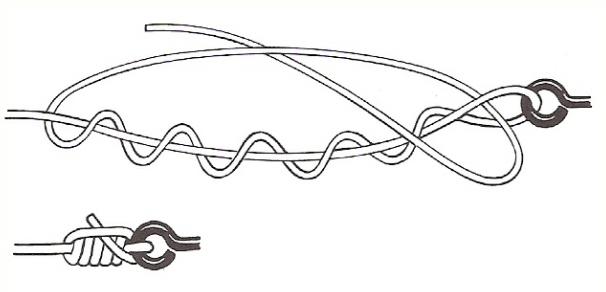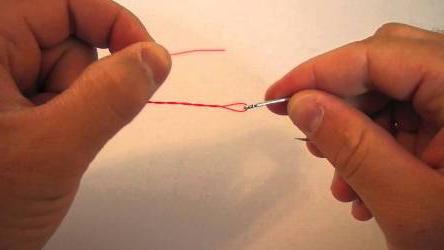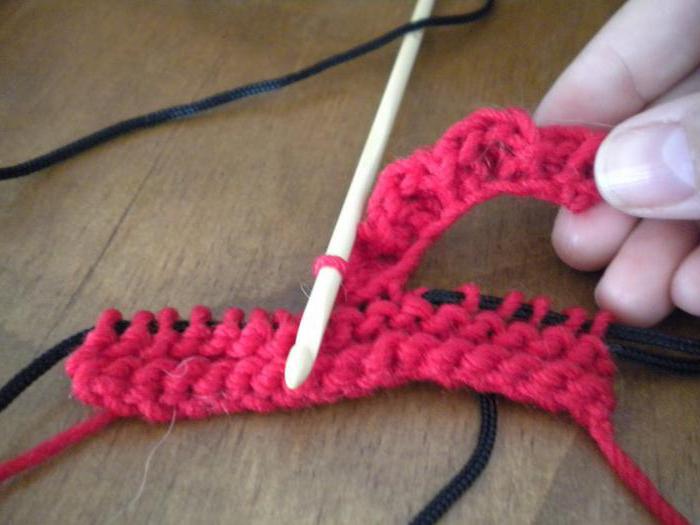Fishing clinch (knot): application and technique of knitting
Knitting fishing knots is a whole science,if not to say art. To learn this is not so easy, but if you start from the very beginning and give enough attention to the lessons, this science is quite possible to comprehend. But first of all, we'll figure out what the fishing knots are and where they are used.
Why do we need fishing knots
Fishing knots are directly related to sea,since most of them were borrowed by fishermen from seafarers. No fishing tackle can do without knots. They stop the floats, tie hooks, baits, boat anchors and boats themselves.

But why can not you use the usualnode? The fact is that under certain loads, any nodes lose their properties, even sea and fishing. Over time, the design is weakened, which leads to slippage of the cord or line and its gradual untying. That's just what happens in all the nodes in different ways. Fishing knots are able to withstand high loads for a long time. They are durable and reliable, although somewhat difficult to manufacture. They say that the more complex the knot, the stronger it is.
We will talk about one of the mostcommon and popular nodes - consider a clinch. His big name already speaks for itself - in English it means "capture". Therefore, there is often another name - the gripping node.
What is a clinch and what is it used for?
A fishing knot clinch is the most popular among fishermen around the world. It is used for binding:
- hooks;
- lures;
- jig-heads;
- wobblers;
- swivels;
- carbines;
- flies, etc.
But what is the clinch knot so good? The fact is that, in addition to universality, it has a very high strength (about 95%) than most other nodes are unlikely to be able to boast. A clinch knot withstands up to 10 kilograms per break, naturally, if it is possible to make a line or cord.
Of course, he also has disadvantages - not all of his varieties are suitable for braided lines, as well as fishing lines with a cross section of more than 0.4 mm.

Varieties of a fishing knot such as a clinch
Clinch has several varieties:
- simple (single) for hook, swivel or bait;
- simple lock;
- improved;
- hardened;
- double.
How to knit a knot of a clinch
To begin, let's look at how to knit a simple knotfor attaching a hook with an eyelet. We take a piece of fishing line, we pass one of its ends into the eye of the hook and return it back, folding the line twice. Holding the hook with one hand, we wind the fishing line with the same end, making 4-5 turns around it. Next, the working end is pulled into the loop formed near the ring itself hook. After this, it is necessary to moisten our design with water and tighten the clinch-knot, stretching the ends of the line to the sides. Cut off the working end, leaving 1-1.5 mm.

Locking clinch
Locking units are used to limit the amplitude of the sliding float movement along the line. They are usually knit not from a monofilament line, but from a thin braid or ordinary woolen thread.
The locking clinch knit is knitted like the usualto tie the hook. Cut the braids or threads in half and lay them on the main line so that it is in the middle. Hold the top of the thread and the fishing line with your hand, wrap it around 4-5 times with one end, then return it to the beginning and pass it into the loop formed by the top of the folded bun. Wet the knot with saliva or water, then carefully tighten it. Be sure to cut off the ends, leaving 1.5-2 mm.
Improved knot of the clinch
This node is an improved version of simple. It is quite popular due to its high reliability. Its strength is about 97%. These knots are often tied to boat anchors.

The process of knitting such a knot is simple - this is a doublerepetition of a simple clinch. Now more. The working end of the length of the line is passed through the hook ring, we return it back and wrap the other end of the 4-5 with turns. Then we pass the end in the loop near the eye of the hook, but do not tighten, but repeat the process, winding the line again. After making 5-6 turns, return the edge of the line to the loop near the eye of the hook and, after moistening the knot, carefully tighten it. Crop the remains of the line, not forgetting to leave 1-1,5 mm.
This node has only one drawback - it is not recommended to use for a braided line.
Reinforced clinch
A strengthened clinch is used to fixhooks, when there is a possibility of high impact on the connection. Recommended for fluorocarbox yarn and braided line. Has a strength of about 95%.
The length of the line is bent in half and skippedtop in the eye of the hook. After stretching the line, fold back so that we have an educated loop on the main thread. With the working end we wind this "tail" 5-7 times and stretch it through the loop. We moisten the formed knot with water and slowly tighten, pulling the hook and the end of the line in different directions. Crop the end, leaving 1-1,5 mm.

Double clinch
A double clinch knot is also designed fortying hooks, carbines and various baits that are amenable to heavy loads. It is a little more complicated, but stronger. In addition, the double knot of the clinch can be knitted both from a monofilament thread and from a braided line. It does not stretch and does not lose its density.
The working edge of the line is pulled through the eye of the hookand we pass it again so that we get a double loop. We twist the line 5-6 times with the working edge, then we pass it through our double loop. We moisten our knot with water and tighten it, stretching for the ends. Cut off the leftovers of the line, leaving 1-1.5 mm.
Tie the fishing knot from the first time can notget, especially if you practice on the line. Therefore, the first training is recommended on a regular cord. It is much more elastic than the line, and it is not difficult to untie it.
</ p>>







